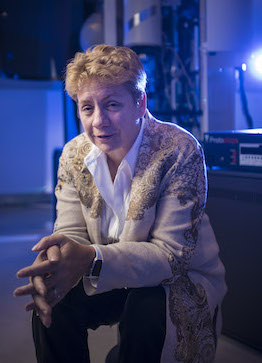Sandra Rosenthal, the Jack and Pamela Egan Professor of Chemistry and director of the Vanderbilt Institute for Nanoscale Science and Engineering, has been named the winner of this year’s Charles H. Herty Medal by the Georgia Section of the American Chemical Society.
The award is given to recognize outstanding chemists in the Southeast U.S. who have made significant contributions to their field.
Rosenthal, who also is a professor of chemical and biomolecular engineering, is being recognized for her development of nanocrystal probes for neuroscience and white-light emitting nanocrystals as well as her contributions to improving STEM education across Tennessee.

(Vanderbilt University / Daniel Dubois)
To help neuroscientists better understand how the neurotransmitter serotonin is regulated, Rosenthal developed a fluorescent nanocrystal “tag” that could be attached to a protein molecule that governs serotonin’s movement through the brain. By watching that tag, researchers identified two different signaling pathways that determined whether serotonin floated freely or anchored to a cell. This advancement could support scientists develop more precise target therapies for disorders related to serotonin regulation, such as depression or bipolar disorder.
The committee also highlighted Rosenthal’s research into white-light emitting nanocrystals, or quantum dots, which could provide the lighting of the future. When an LED illuminates tiny fluorescent beads of cadmium selenide, the beads emit the type of soft, warm white light that feels most natural to our eyes. In more recent years, Rosenthal boosted their lighting efficiency to make them comparable to some specialty commercial lighting applications, and last year she headed a team that developed a way to use them to build more precise lasers. This technology has informed other research at Vanderbilt as well, most recently in the Department of Civil and Environmental Engineering.
Additionally, Rosenthal was the first to figure out how to correlate the atomic structure of a single nanocrystal to its photophysics, advancing science’s understanding of how quantum dots actually work.
She is a frequent collaborator with School of Engineering faculty and very active in outreach efforts and was instrumental in helping secure the $20 million NSF grant that supports the TN-SCORE program, which seeks to improve STEM education in Tennessee. As part of that effort, VINSE hosts field trips for Middle Tennessee high school students to learn about nanotechnology through an experiment that challenges them to use blackberry juice to develop solar cells.
Rosenthal is the second Vanderbilt chemist to win the award since its inception in 1933; Stanley Tarbell won it in 1973.
“I didn’t hesitate when asked to join the leadership team for TN-SCORE. Vanderbilt is my home, which makes Tennessee my home, so it is natural to want to help the state,” said Rosenthal. “You do things because they are the right thing to do, not for awards or recognition. But recognition in the form of the Herty Medal is very satisfying.”
Media Inquiries:
Liz Entman, (615) 322-NEWS
Liz.entman@vanderbilt.edu